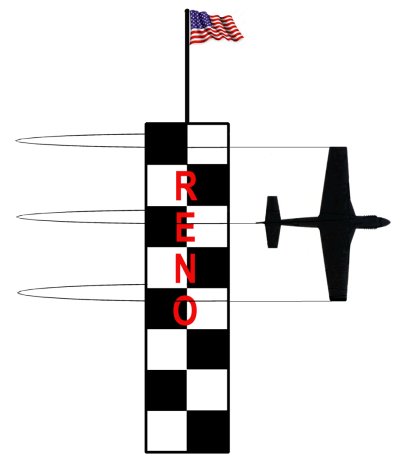

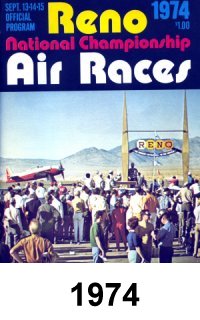
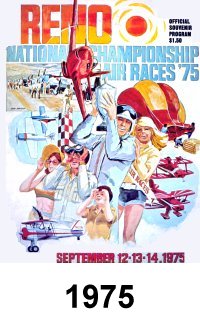
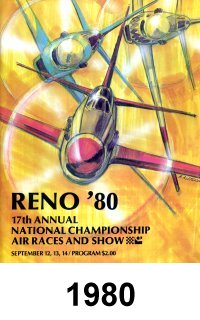
 |
 |
||
 |
 |
 |
|
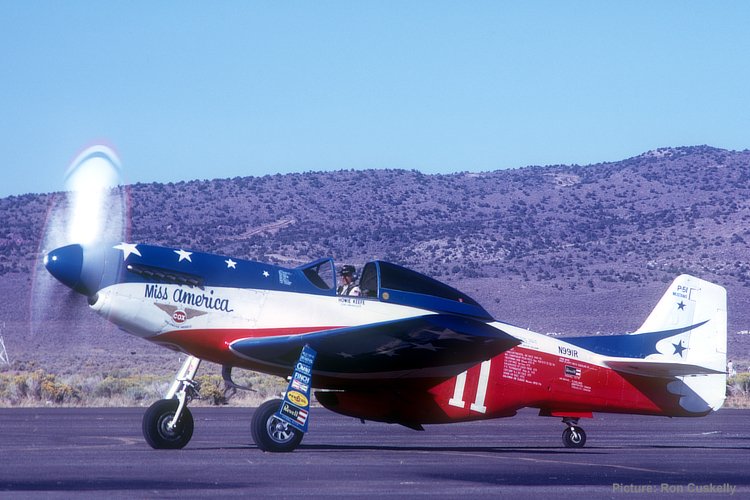 |
||||||||||||||||||||
|
The archetypal racing Mustang, P-51D N991R Miss America Race #11. Although basically stock, this attractively presented aircraft was a regular participant at Reno in the hands of owner Howie Keefe. In 1974 the aircraft qualified 4th at 407.31 mph.
|
||||||||||||||||||||
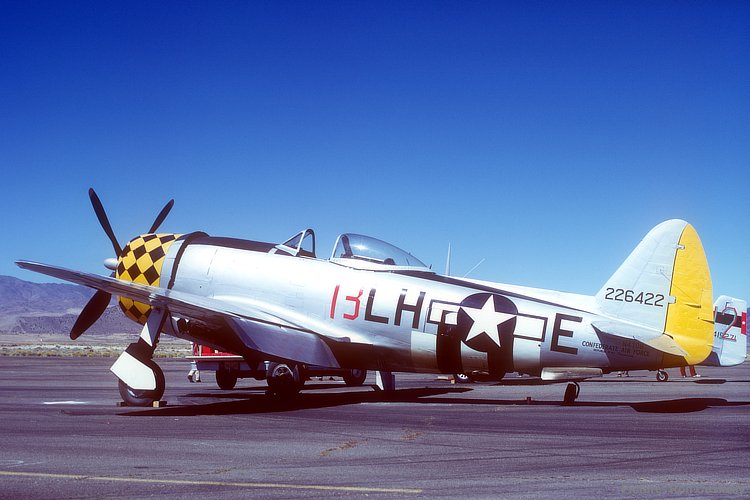 |
||||||||||||||||||||
|
Republic P-47D N47DB Race #13 of the Confederate Air Force participated in two races in 1974 flown by Lefty Gardner, one of the founders of the CAF. The aircraft qualified last in a field of 18 Unlimiteds at 289.76 mph but clearly Lefty was not pushing the stock warbird. The unofficial Race #13 was used for this race only.
|
||||||||||||||||||||
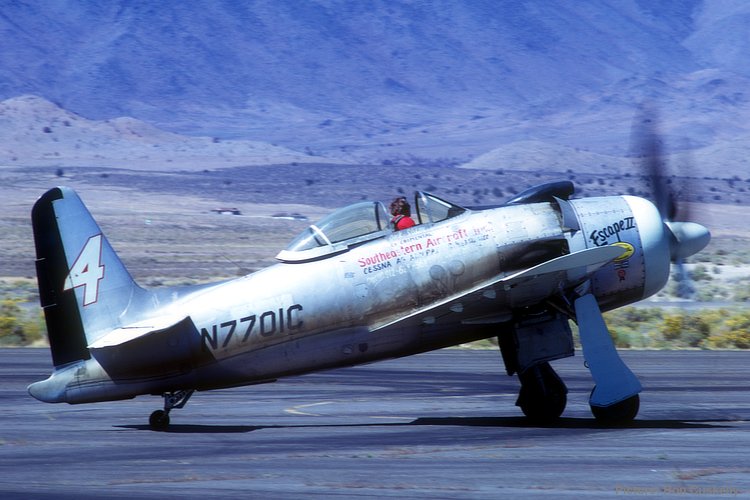 |
||||||||||||||||||||
|
Grumman F-8F-2 Bearcat N7701C Race #4 Escape II was fitted with a Pratt & Whitney R-2800 with cowling and air scoop from a Martin 202. For the 1974 event the aircraft qualified 6th at 396.00 mph. Tragically, while returning from the 1975 Reno event, the aircraft crashed killing the owner Jack Sliker.
|
||||||||||||||||||||
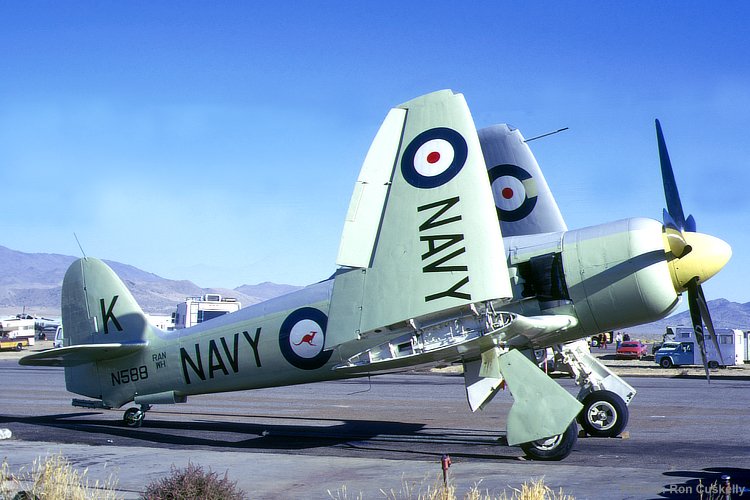 |
||||||||||||||||||||
|
Formerly VH-BOU, Sea Fury N588 Race #16 Baby Gorilla was flown by owner Lloyd Hamilton. The Sea Fury qualified 8th at 387.39 mph. The aircraft was photographed parked at the back of the pits on 14 September 1974 after blowing a cylinder (reportedly through the cowling!) at the start of a race the previous day.
|
||||||||||||||||||||
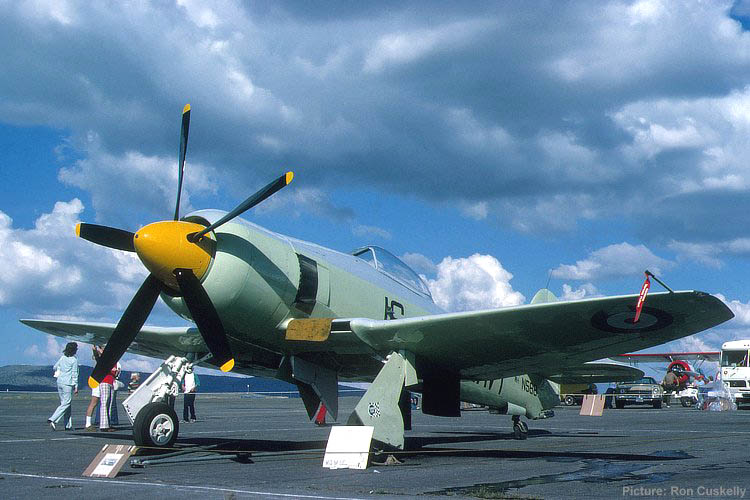 |
||||||||||||||||||||
|
For the 1975 races, Sea Fury N588 Race #16 Baby Gorilla qualified 14th at 367.88 mph. This year the aeroplane featured a second seat and a lengthened canopy.
|
||||||||||||||||||||
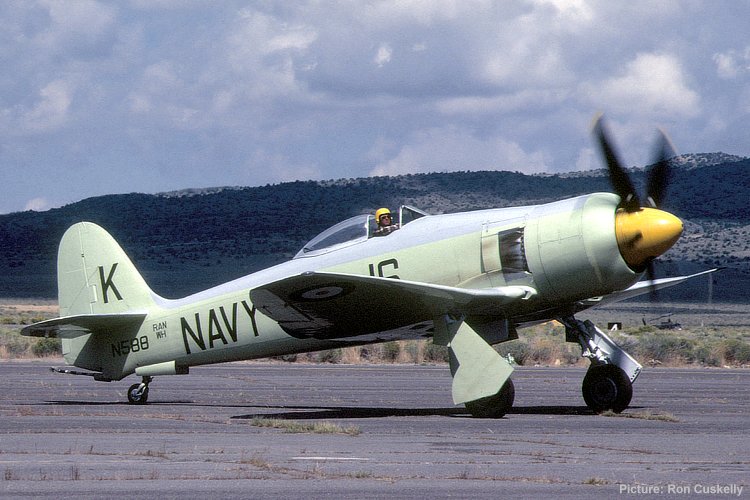 |
||||||||||||||||||||
|
Owner Lloyd Hamilton at the controls of Sea Fury N588 Race #16 Baby Gorilla on on 11 September 1980. This year the aircraft qualified 12th at 363.47 mph.
|
||||||||||||||||||||
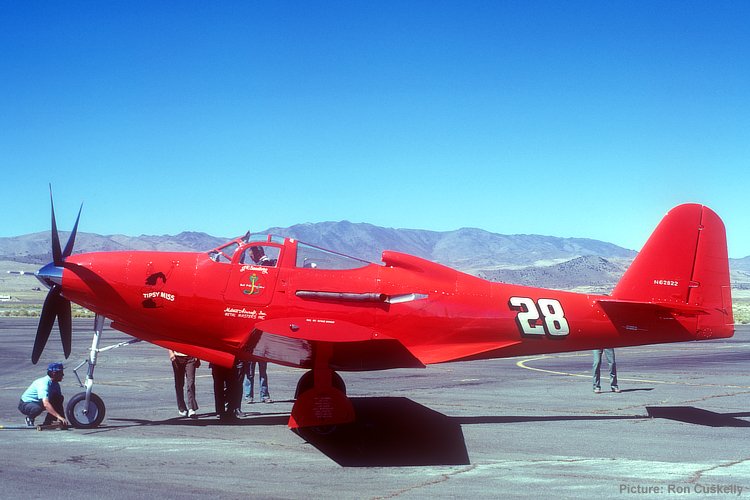 |
||||||||||||||||||||
|
Bell P-63C Kingcobra N62822 Race #28 Tipsy Miss was flown by Lefty Gardner but retired during the first heat on 13 September 1974 with a burnt piston. The aircraft had qualified 11th at 372.80 mph.
|
||||||||||||||||||||
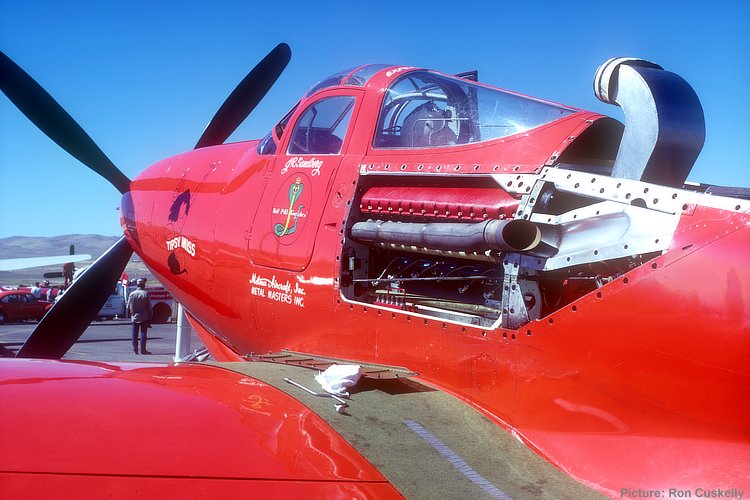 |
||||||||||||||||||||
|
The Allison V-1710 engine in Bell P-63C N62822 Race #28 Tipsy Miss. The name may derive from the fact that the engine was originally intended to run on alcohol fuel.
|
||||||||||||||||||||
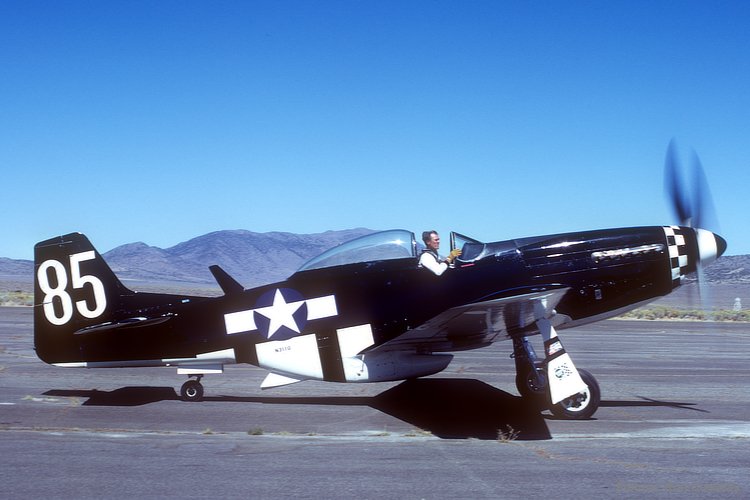 |
||||||||||||||||||||
|
P-51D N311G Race #85 with Clay Klabo at the controls. The aircraft was known as Iron Mistress although the name was not painted on the aeroplane until later. For the 1974 event the aircraft qualified 9th at 375.16 mph.
|
||||||||||||||||||||
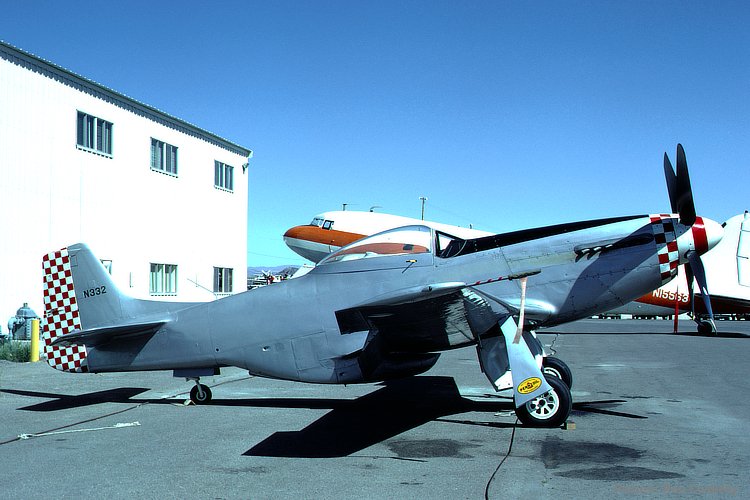 |
||||||||||||||||||||
|
P-51D N332 was not a racer at the time but the aircraft did belong to racing engine builder Dave Zeuschel when photographed at Reno on 11 September 1974. However, part of the aeroplane did attempt to qualify at Reno in 1974. Ken Burnstine's Miss Foxy Lady shed its pointed prop spinner during its first unsuccessful attempt at qualifying and the spinner was replaced with one borrowed from N332 for a second qualifying attempt which was also unsuccessful. Following a crash in 1979, parts of N332 were used in the construction of Race #84 Strega although this aircraft was subsequently returned to stock configuration.
|
||||||||||||||||||||
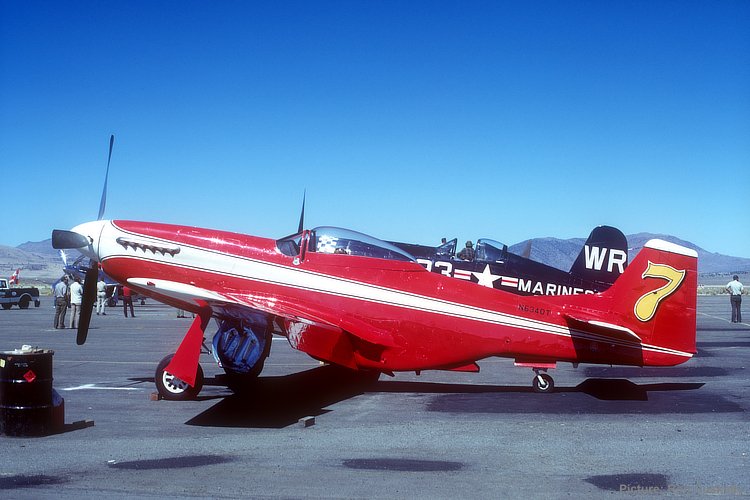 |
||||||||||||||||||||
|
P-51D N6340T Race #7 was qualified by Edward J. Modes. It subsequently acquired the name Candy Man. For the 1974 races the aircraft qualified 13th at 356.40 mph. The aircraft subsequently flew in the UK before going to the Air & Space Museum at Eskisehir, Turkey in 2018.
|
||||||||||||||||||||
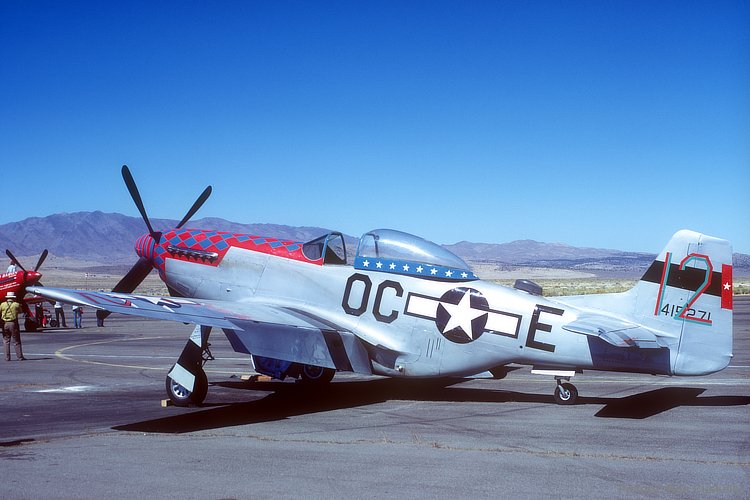 |
||||||||||||||||||||
|
P-51D N9146R Race #12 was qualified 16th at 314.84 mph by Gerald Martin for the 1974 season. The aircraft currently flies as a warbird in the US.
|
||||||||||||||||||||
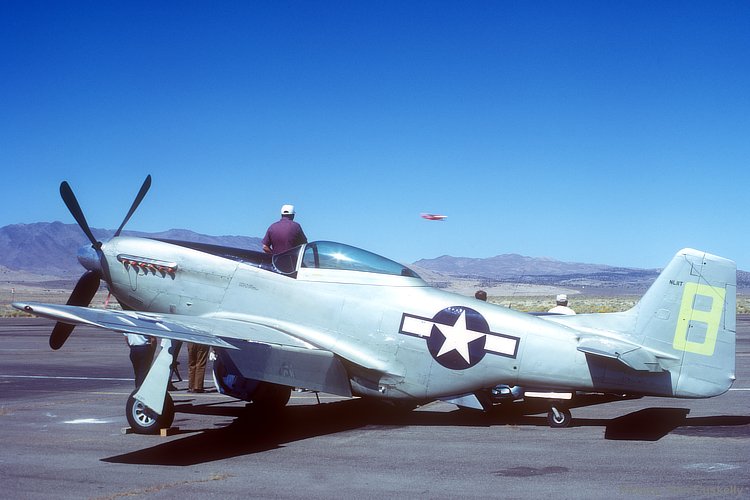 |
||||||||||||||||||||
|
P-51D NL11T Race #8 was entered by John Herlihy under the name Sweet P although it does not appear on the aircraft in this photo. For the 1974 races the aircraft qualified 14th at 355.69 mph. The aeroplane is currently flying in the Netherlands as PH-PSI.
|
||||||||||||||||||||
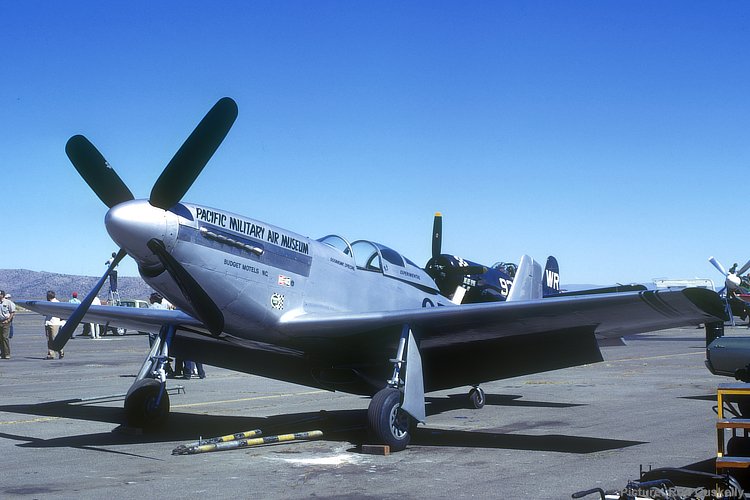 |
||||||||||||||||||||
|
P-51D N576GF Oogahonk Special Race #97 was flown by Korean War ace Bob Love. For the 1974 races the aircraft qualified 5th at 402.71 mph.
|
||||||||||||||||||||
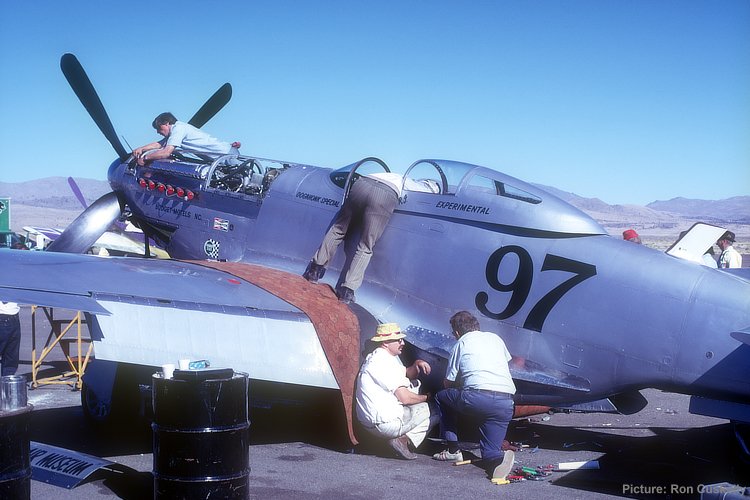 |
||||||||||||||||||||
|
P-51D N576GF Oogahonk Special Race #97 was flown by Korean War ace Bob Love who is leaning into the cockpit. The aircraft came 4th in the first heat on 13 September 1974 which no doubt prompted a quest for extra speed the next day with the addition of extended wing fillets. In the Championship race on the Sunday the aircraft crossed the finish line in 2nd position but was penalised and dropped to 6th. Currently the Mustang flies as N451EA.
|
||||||||||||||||||||
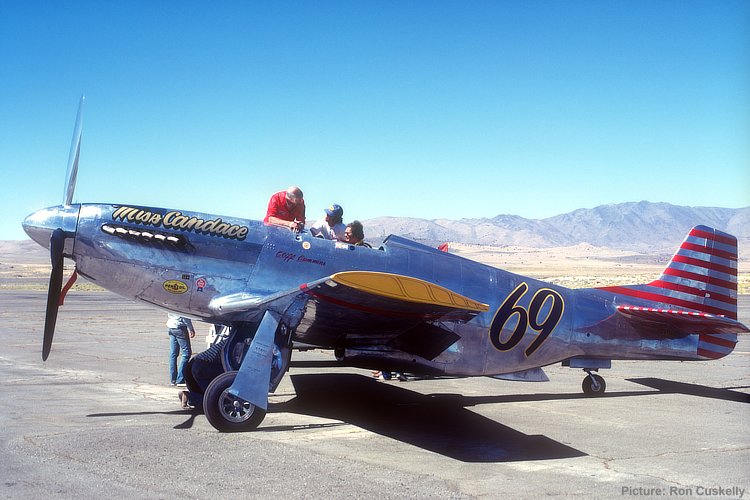 |
||||||||||||||||||||
|
P-51D N79111 Miss Candace Race #69, one of the more radically modified Mustangs, was flown by Dr Cliff Cummins. In 1974 the aircraft qualified 2nd at 420.28 mph. The aeroplane retired on lap 2 of Heat 2 with electrical failure and did not compete further. The red stripes on the tail are a tribute to the pilot's wartime Thunderbolt squadron.
|
||||||||||||||||||||
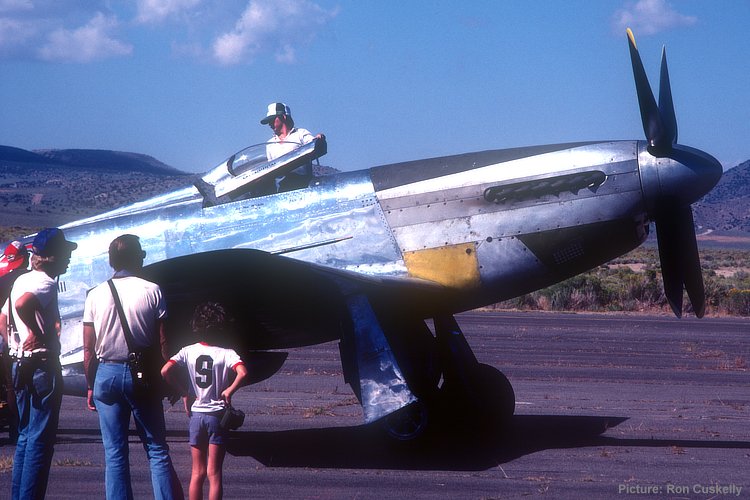 |
||||||||||||||||||||
|
By the 1980 races, P-51D N79111 Race #69 had changed hands and was renamed Jeannie to honour the wife of the new owner Wiley Sanders. On 4th September, a week before Reno, the aircraft was being test-flown by engine builder Dave Zeuschel when the engine failed on take-off from Van Nuys, necessitating a forced landing in a cornfield. The damage was extensive but the owner was prepared to throw money and manpower at the rebuild and the Mustang made it to Reno on 10 September just in time for Mac McClain to qualify 6th at 396.35 mph. As the patchwork quilt appearance attests, the aeroplane was not yet fully race ready.
|
||||||||||||||||||||
 |
||||||||||||||||||||
|
P-51D N79111 Race #69 Jeannie one day after the previous photo by which time the patchwork appearance of the aircraft was much improved. One casualty of the forced landing was the custom-built low profile belly scoop which was replaced with a stock unit. The so-called "doghouse" below the race number 69 was also replaced.
|
||||||||||||||||||||
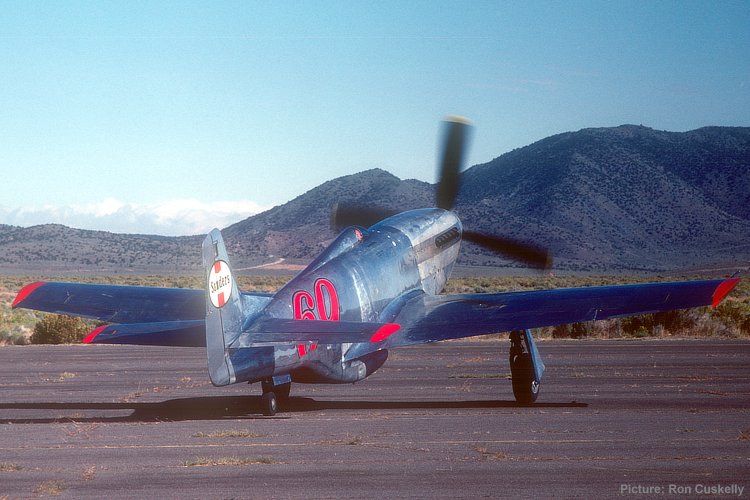 |
||||||||||||||||||||
|
P-51D N79111 Race #69 Jeannie on 13 September the day of the Gold Race in which the aircraft placed 2nd at 392.28 mph.
|
||||||||||||||||||||
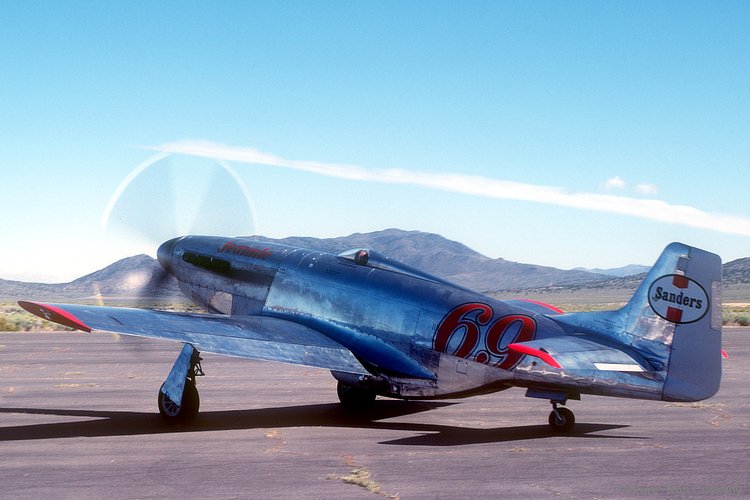 |
||||||||||||||||||||
|
P-51D N79111 Race #69 Jeannie on 14 September the day of the Championship Gold Final which it won at a record speed of 433.01mph. This was a truly outstanding achievement for an aeroplane that was sitting on its belly in a cornfield just ten days previously. In 1981, Jeannie was sold to Jimmy Leeward who made further extensive modifications including the elimination of the belly scoop in favour of a boil-off cooling system. In this configuration the aeroplane was renamed Galloping Ghost, the name it had carried when it raced in the Thompson Trophy Race in 1946. Tragically, during the Reno races on 16 September 2011, the aircraft crashed into the pit area killing the pilot Jimmy Leeward and ten spectators. The aeroplane was totally destroyed by impact forces.
|
||||||||||||||||||||
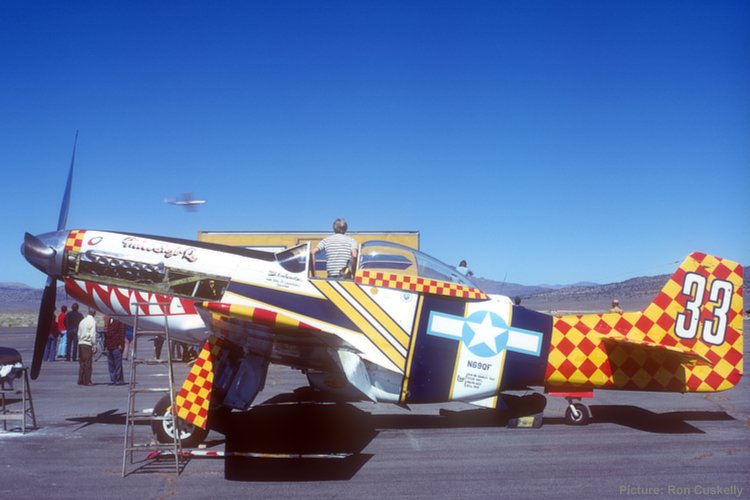 |
||||||||||||||||||||
|
P-51D N69QF Miss Suzie Q Race #33 was entered by Ken Burnstine in 1974. The colour scheme was allegedly conceived by a committee on a night of celebration. The design reflects a colourful character who drew attention from law enforcement agencies for his Florida based operation of several Lockheed Lodestars importing herbal products from South America. For the 1974 races the aircraft qualified 7th at 392.94mph. This aeroplane served as the backup aircraft for Burnstine's more radically modified P-51D N70QF Miss Foxy Lady Race #34 (see below). When N70QF failed to qualify because of mechanical troubles, Burnstine competed in the Championship Gold race in N69QF, taking first place at 381.48mph in a diminished field of only seven racers. Ken Burnstine later lost his life when this aeroplane crashed on 16 June 1976 in the lead-up to the Mojave races.
|
||||||||||||||||||||
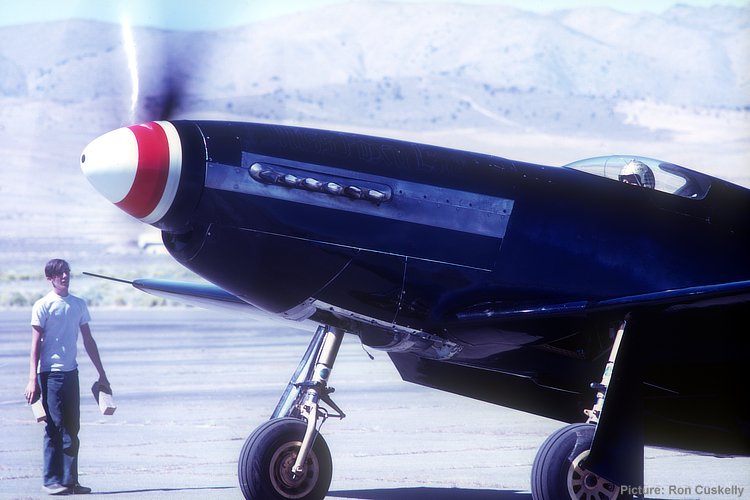 |
||||||||||||||||||||
|
P-51D N70QF Miss Foxy Lady Race #34 returning after an abortive qualifying attempt on 12 September. The aircraft is wearing a replacement spinner (borrowed from Dave Zeuschel's N332) after its more pointed unit came off during an earlier qualifying attempt. During a second attempt at qualifying, the engine backfired blowing off the lower cowl panel. Clearly it had been a rush to get the aeroplane to Reno as there are no markings on the aircraft.
|
||||||||||||||||||||
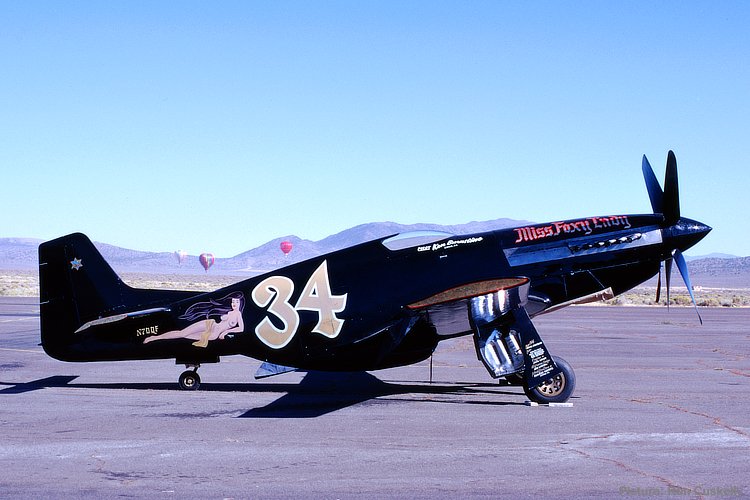 |
||||||||||||||||||||
|
P-51D N70QF Miss Foxy Lady Race #34 was already out of the competition when these controversial markings were applied in the Reno pits. A word frequently used to describe this aircraft is "sinister". Note the temporary covering where the lower cowl had been, the original being somewhere out there in the desert.
|
||||||||||||||||||||
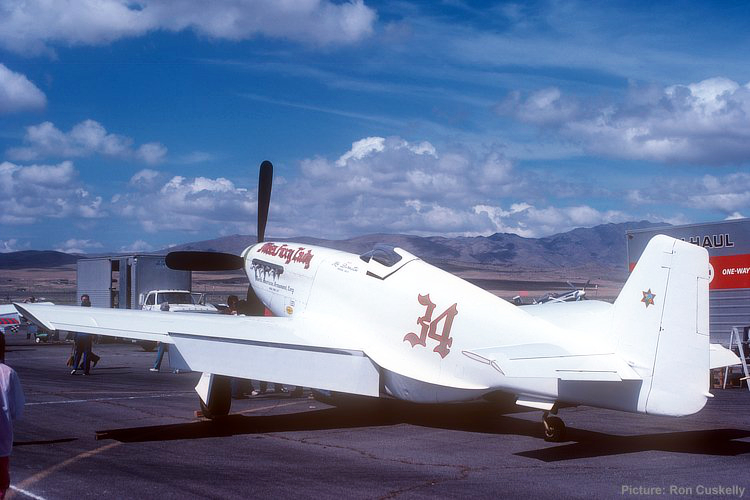 |
||||||||||||||||||||
|
P-51D N70QF Miss Foxy Lady Race #34 was back at Reno in 1975 in a new white colour scheme. Again a signwriter later applied a last minute female adornment in the Reno pits. Flown by Ken Burnstine, the aircraft qualified 3rd at 421.51mph behind two Bearcats. In the Championship race on 14 September the aircraft retired on the seventh lap with a blown engine.
|
||||||||||||||||||||
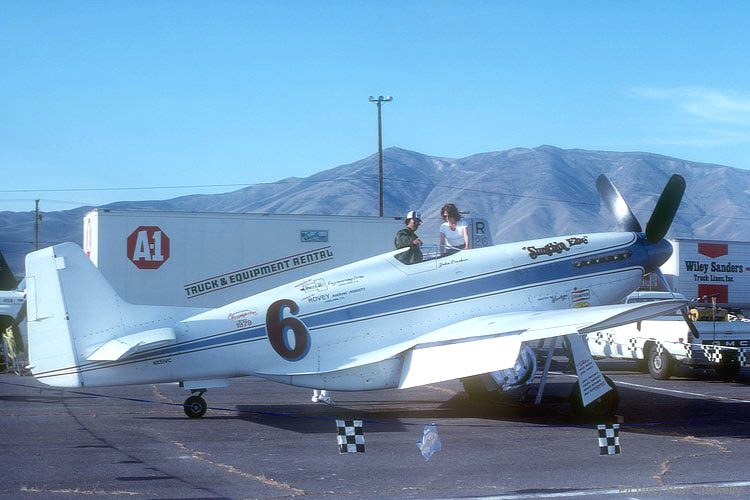 |
||||||||||||||||||||
|
After Ken Burnstine's death, Miss Foxy Lady was acquired by John Crocker who entered the aeroplane in the 1976 races as Race #6. In an apparent attempt at distancing himself from the previous owner's reputation, the racer was re-registered NX51VC and renamed Sumthin' Else. Also a blue cheatline was added to the white livery. For the 1980 races John Crocker qualified the aircraft 2nd at 418.34mph. In the Championship Gold race on Sunday 14 September Crocker came second at 429.78 mph behind Jeannie.
|
||||||||||||||||||||
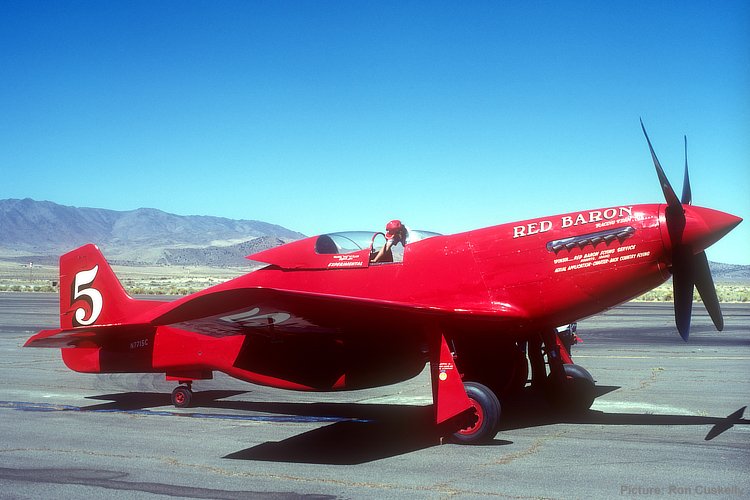 |
||||||||||||||||||||
|
P-51D N7715C Red Baron Race #5 had competed previously at Reno with several owners and in varying colour schemes. For Reno 1974 the aircraft was entered by the Red Baron Racing Team in this striking red colour scheme. The aircraft was qualified 3rd at 417.33mph in the hands of Mac McClain.
|
||||||||||||||||||||
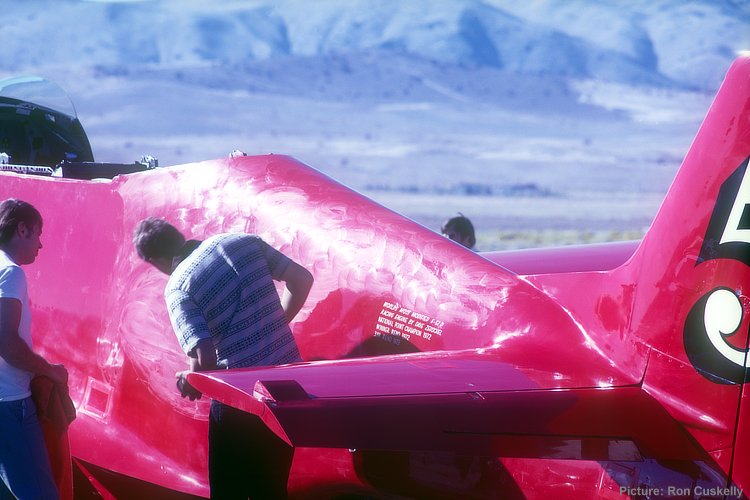 |
||||||||||||||||||||
|
In the quest for speed, too much polishing is never enough. P-51D N7715C Red Baron Race #5 receives some TLC from her crew the day before its first race in which it came 2nd at 400.37 mph behind Lyle Shelton's Bearcat.
|
||||||||||||||||||||
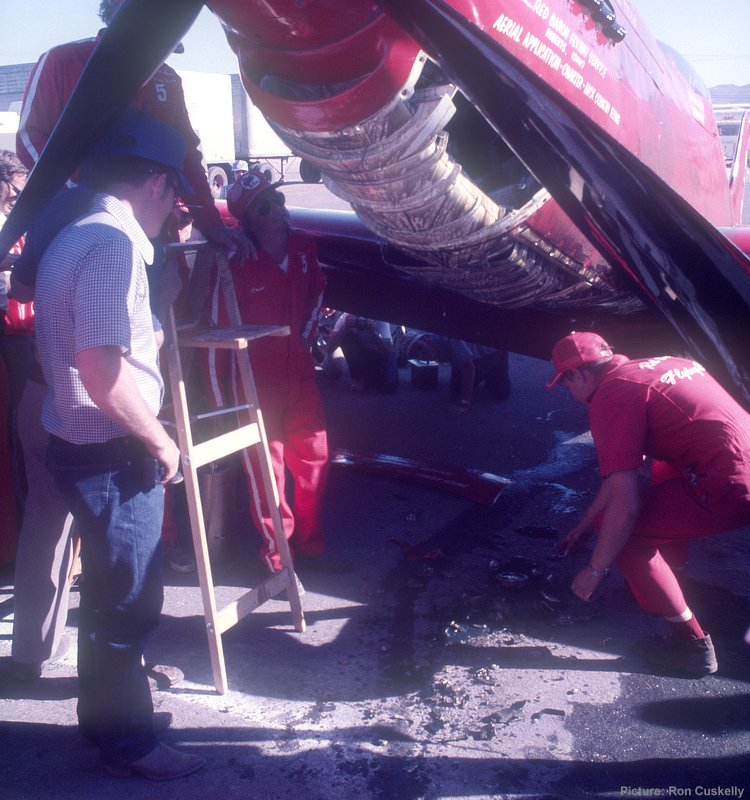 |
||||||||||||||||||||
|
Never mind the metal in the screens, look what fell out when they removed the bottom cowl. During the Championship Gold race on 15 September 1974, Red Baron pulled out on the second lap with a blown engine. This was the aftermath when they got the aeroplane back to the pits.
|
||||||||||||||||||||
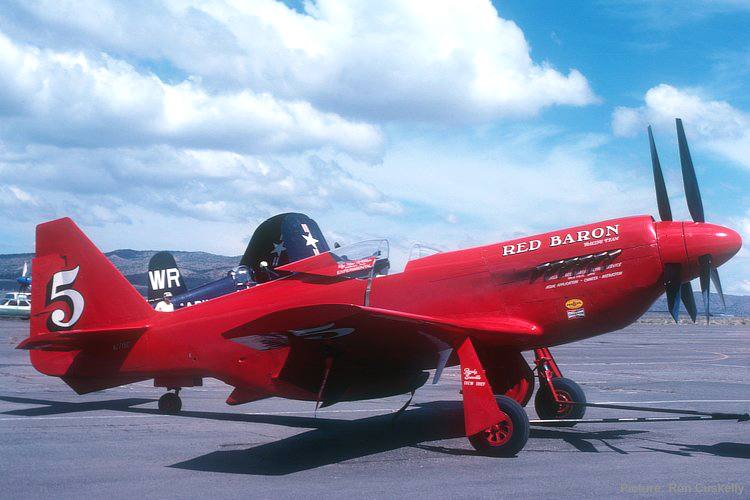 |
||||||||||||||||||||
|
Better get a bigger engine! For Reno 1975 the Red Baron was back with a Rolls Royce Griffon and contra-rotating propellers from a Shackleton. The heavier Griffon was mounted farther aft for balance and the vertical tail surfaces were enlarged for directional stability. So extensive were the modifications that the aeroplane was henceforth known as the RB-51. The small ventral fin was subsequently removed. The aircraft qualified 6th at 407.39mph in the hands of Mac McClain.
|
||||||||||||||||||||
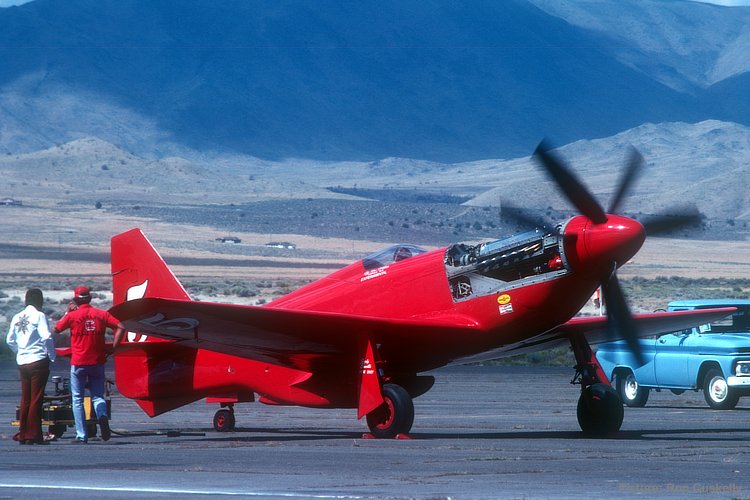 |
||||||||||||||||||||
|
RB-51 N7715C Red Baron Race #5 photographed on 14 September the day of the Championship race in which the aircraft came 2nd at 427.31 mph. Winner was Lyle Shelton's Bearcat at a race record speed of 429.92 mph. Out of a field of seven Unlimiteds, only four finished. For the 1977 season the RB-51 was flown by Darryl Greenamyer with Steve Hinton taking over in 1978. On 14 August 1979 the RB-51 set a new world speed record of 499.018 mph on a 3 km measured course at Tonopah, Nevada, surpassing the previous record held by Darryl Greenamyer's Bearcat. In the Championship Gold race at Reno the following month, immediately after crossing the finish line in 2nd place, the Red Baron's props went into flat pitch and the aircraft crashed seriously injuring Steve Hinton. Hinton made a complete recovery and still flies warbirds today along with his son Steve Jr. The RB-51 was totally destroyed by impact and fire.
|
||||||||||||||||||||
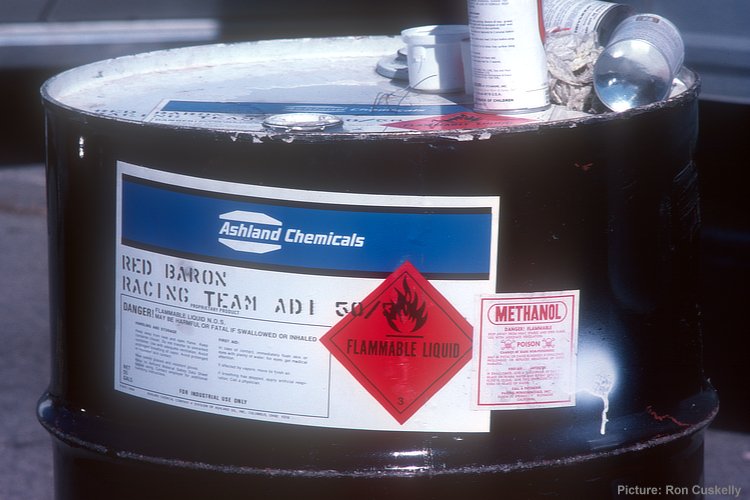 |
||||||||||||||||||||
|
Many of the Unlimiteds use Anti Detonant Injection (ADI). A 50/50 mixture of Methanol and Water is injected into the intake manifolds to facilitate a more even burning of the charge. The contents of this drum were consumed by the Red Baron RB-51. Many of the liquid cooled engines also use spray bars upstream of the radiators to assist with cooling but these use neat water.
|
||||||||||||||||||||
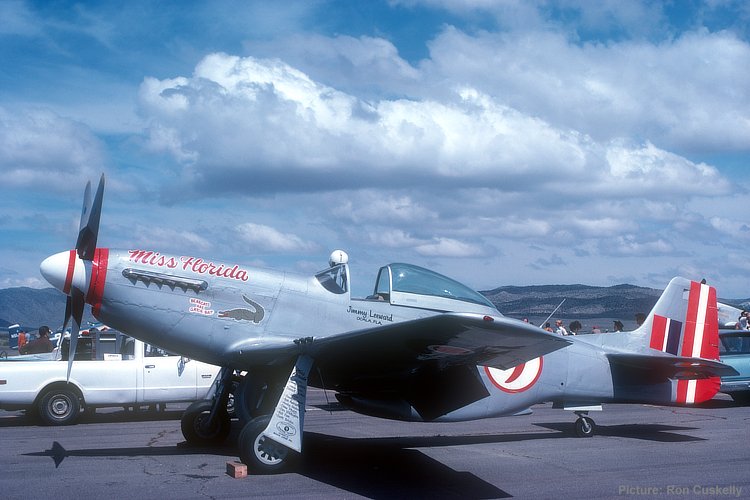 |
||||||||||||||||||||
|
P-51D N9LR Miss Florida Race #9 was qualified 15th at 366.74 mph by owner Jimmy Leeward in 1975. Although basically stock, the aeroplane won the 1975 Medallion race at 362.47 mph. Jimmy Leeward later acquired the former Jeannie in which he tragically lost his life in this general area of the Reno pits in 2011.
|
||||||||||||||||||||
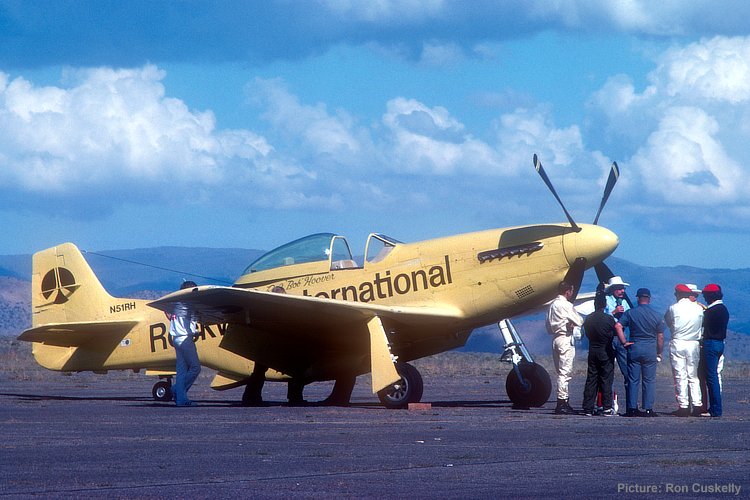 |
||||||||||||||||||||
|
Not strictly a racer but it was always there. P-51D N51RH was owned by Rockwell International and flown as the pace aircraft by the incomparable Bob Hoover who is seen here in the white hat briefing Unlimited pilots before a 1975 race.
|
||||||||||||||||||||
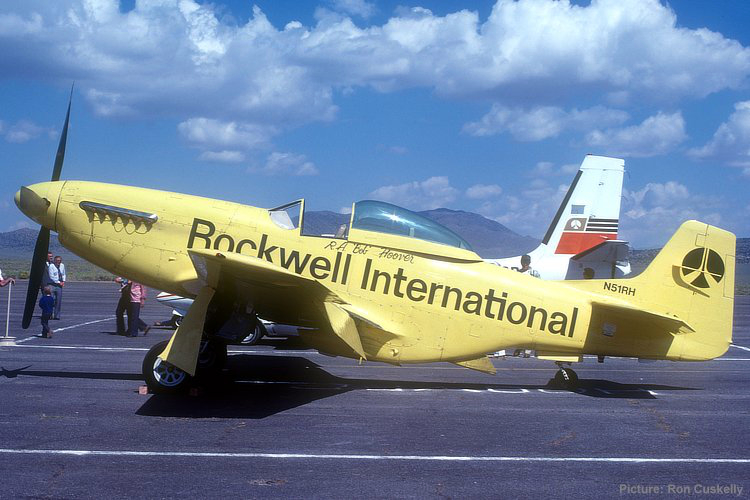 |
||||||||||||||||||||
|
Bob Hoover's P-51D N51RH in the Reno pits in 1980 with his Shrike Commander N500RA in the background. Mr Hoover flew both aircraft in the pre-race airshow as only he could.
|
||||||||||||||||||||
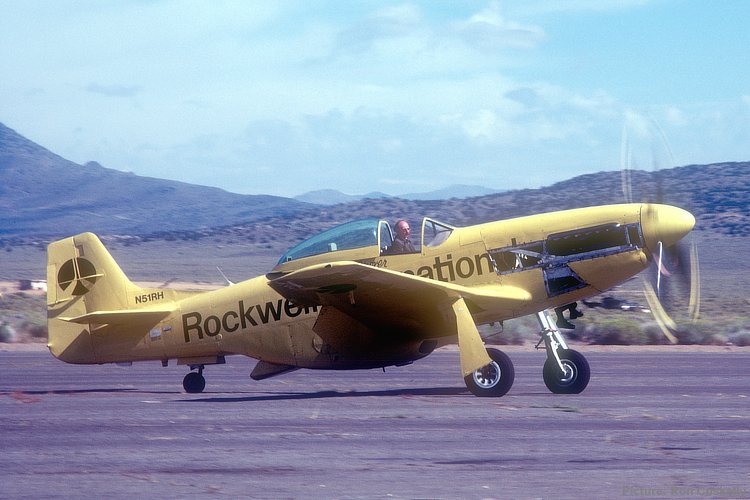 |
||||||||||||||||||||
|
Always sartorially elegant, Bob Hoover even wears jacket and tie to do an engine run! P-51D N51RH experienced some engine problems at Reno in 1980. Indeed, on the day after this photo was taken, as the Unlimiteds took-off for the Silver race on 13 September, Bob Hoover declared an emergency and landed immediately, leaving the field without a pace aircraft for the first time since 1964. The role of starting the race was assumed by the pole position aircraft. Robert A. 'Bob' Hoover, born 24 January 1922, passed away from natural causes on 25 October 2016 at age 94. N51RH is still flying registered to John K. Bagley, 51RH LLC, Rexburg ID.
|
||||||||||||||||||||
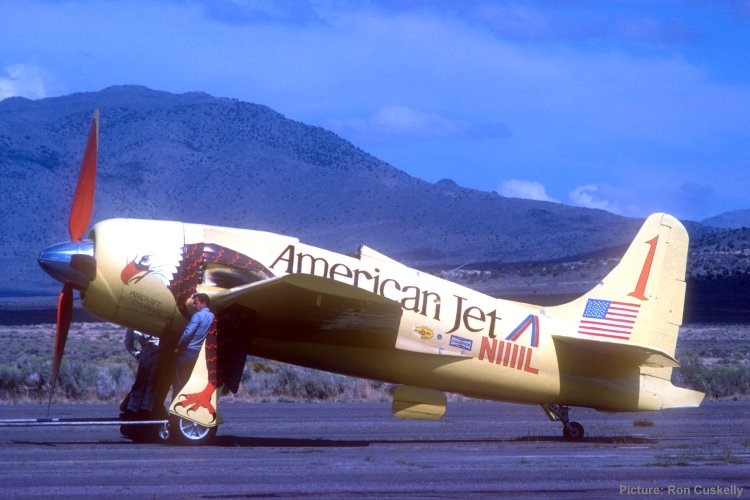 |
||||||||||||||||||||
|
Grumman F8F-2 Bearcat N1111L Race #1, as the racing number suggests, had a long and distinguished career as a racer beginning in 1964. In the hands of Lockheed test pilot Darryl Greenamyer, the Bearcat won at Reno six times in the period 1965 to 1971. On 16 August 1969, the aircraft broke the 30-year-old world speed record for piston-engined aircraft held by German pilot Fritz Wendel in the Messerschmitt Me 209. The Bearcat beat the record with a speed of 483.041 mph. Following this achievement, the aeroplane was named Conquest 1. After an absence of several years, the aircraft returned to Reno in 1975, qualifying fastest at 435.56 mph, a new national qualifying record. Unfortunately, because of prop control problems, the aeroplane did not compete further in 1975.
|
||||||||||||||||||||
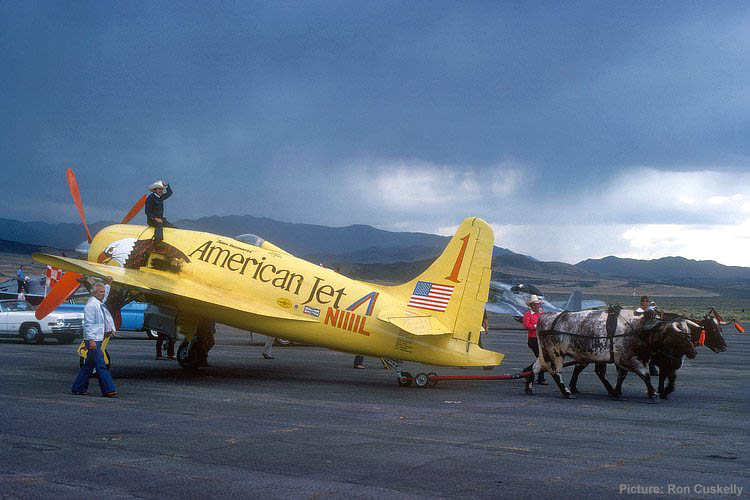 |
||||||||||||||||||||
|
On 13 September 1975, the day before the Championship race in which the Bearcat was due to compete, the aircraft was towed down the crowd line by a bullock team with Darryl Greenamyer perched precariously atop the aircraft fighting strong winds. This was the aircraft's last appearance at Reno and in 1977 Greenamyer donated Conquest I to the Smithsonian National Air and Space Museum in Washington, DC.
|
||||||||||||||||||||
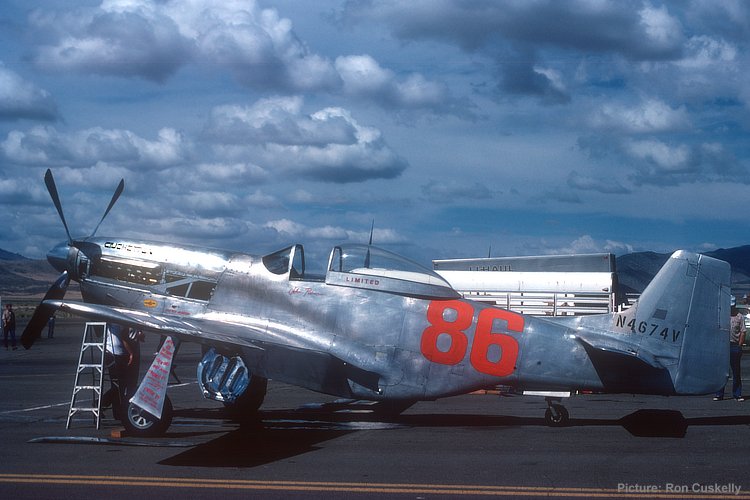 |
||||||||||||||||||||
|
The obvious superior build quality will tell you that this is an Australian-built Commonwealth Aircraft Corporation CA-18 Mustang. N4674V Race# 86 Ciuchetton was once A68-198 with the Royal Australian Air Force. The aircraft was owned by Joe Banducci and Elmer Rossi and flown by John Putman who qualified for Reno 1975 in 11th at 383.06 mph.
|
||||||||||||||||||||
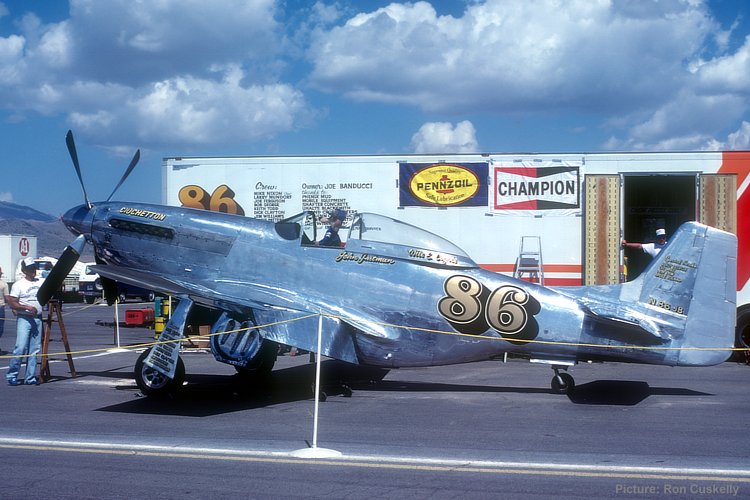 |
||||||||||||||||||||
|
By Reno 1980, Ciuchetton Race #86 had a new registration N86JB which reflected sole ownership by Joe Banducci. Piloted again by John Putman, the aircraft qualified 3rd at a creditable 412.49 mph. Since photographed in 1975, the appearance has improved dramatically with a highly polished natural metal finish.
|
||||||||||||||||||||
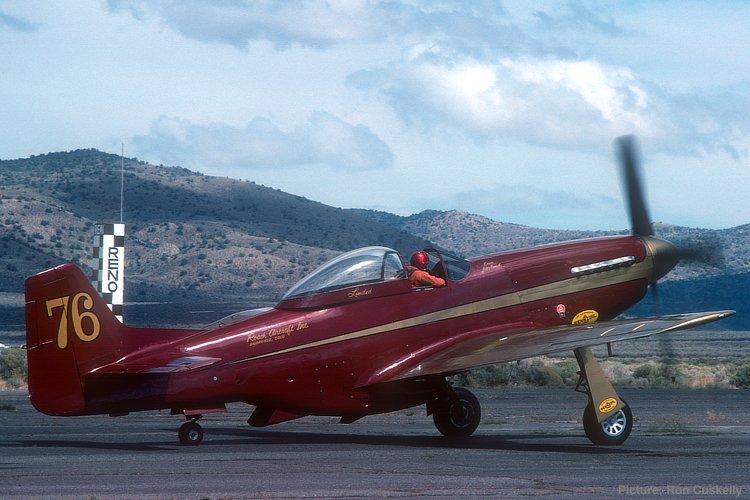 |
||||||||||||||||||||
|
P-51D N5466V No Name Dame Race #76 qualified 18th at 332.52 mph for the 1975 races flown by Dave Norland. The aircraft placed 4th in the Medallion race and did not compete further.
|
||||||||||||||||||||
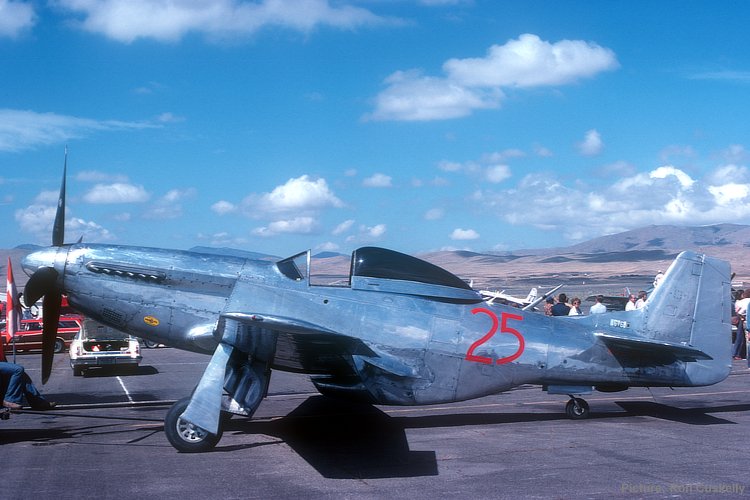 |
||||||||||||||||||||
|
P-51D N6168C Race #25 was flown by Lefty Gardner and qualified 10th at 384.73 mph for the 1975 event. In the Consolation race the aircraft crossed the line in 4th position but because of a pylon cut was dropped to last in the field of seven.
|
||||||||||||||||||||
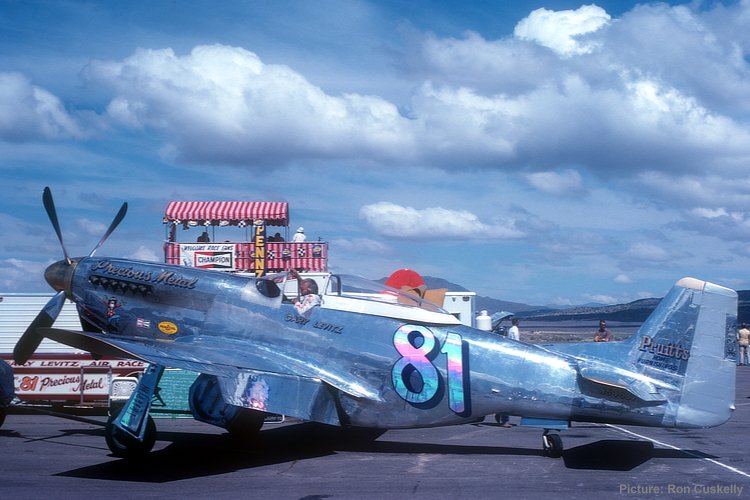 |
||||||||||||||||||||
|
P-51D N5483V Precious Metal Race #81 qualified 5th at 409.28 mph for the 1975 races flown by Gary Levitz who is seen in the cockpit. This year was the first time in Unlimited air racing history that all seven of the aircraft that qualified for the Championship race did so in excess of 400 mph.
|
||||||||||||||||||||
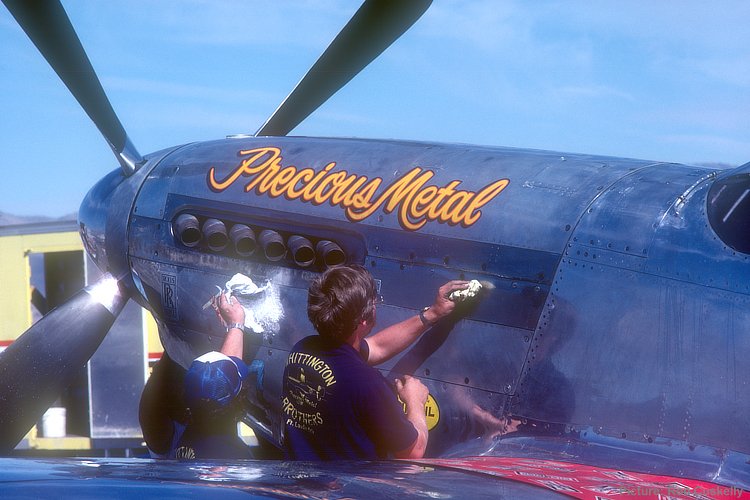 |
||||||||||||||||||||
|
P-51D N5483V Precious Metal Race #81 was even shinier for the 1980 races but the aircraft did not qualify because of mechanical problems. Owner Gary Levitz proceeded to qualify in his backup P-38 Lightning (see below).
|
||||||||||||||||||||
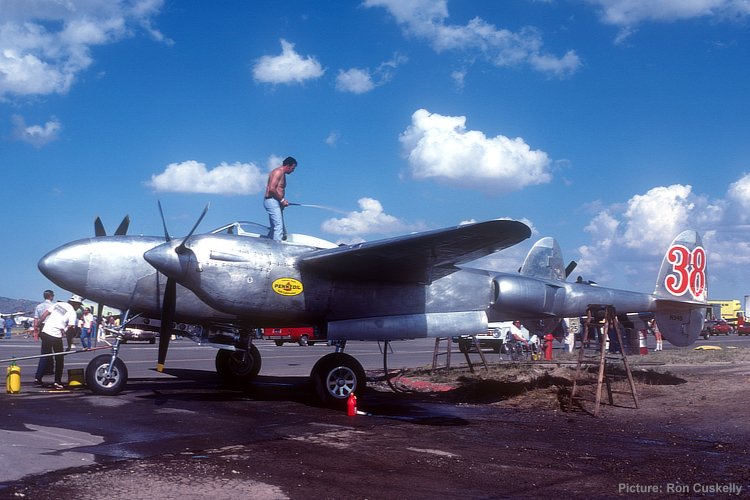 |
||||||||||||||||||||
|
P-38L N345 Double Trouble Race #38 qualified for the 1980 races in 17th at 339.85 mph flown by owner Gary Levitz. The aeroplane was photographed on 11 September 1980 being washed down with a fire hose at the back of the pits. It must be a fire hose because nobody would be that disrespectful to a P-38.
|
||||||||||||||||||||
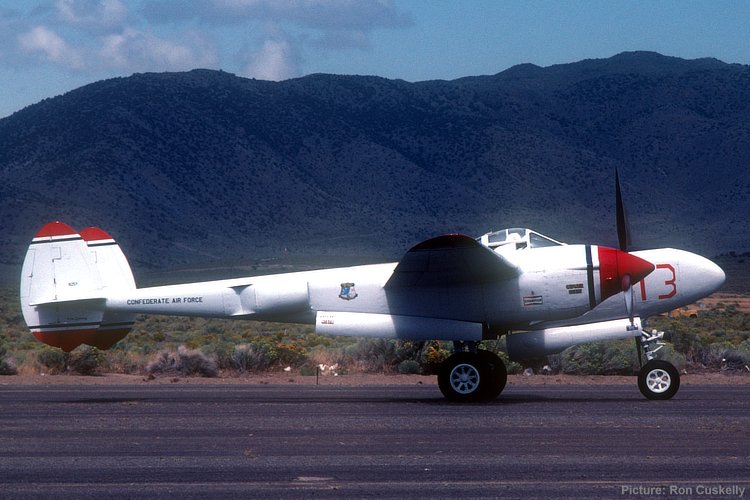 |
||||||||||||||||||||
|
P-38L N25Y Race #13 photographed on 13 September 1980. Lefty Gardner qualified the Lightning 19th at 328.49 mph and flew it to 3rd place in the Bronze Final.
|
||||||||||||||||||||
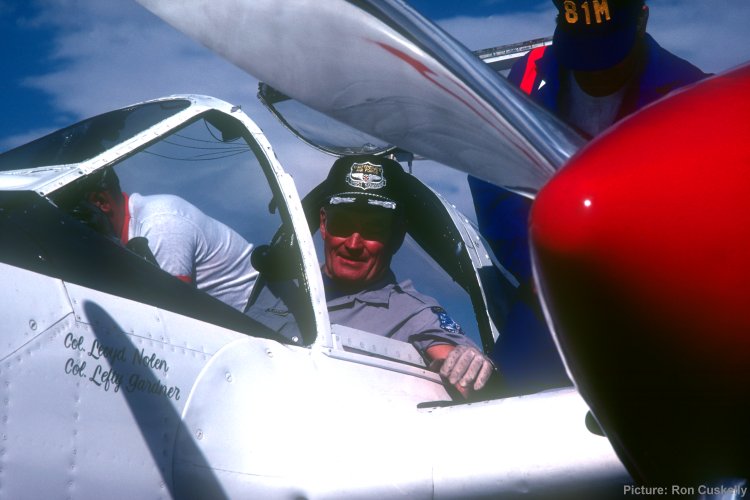 |
||||||||||||||||||||
|
Lefty Gardner in the cockpit of P-38L N25Y Race #13. After Lefty Gardner passed away, the Lightning was acquired by the owner of Red Bull and given a ground-up restoration and a highly polished natural metal finish. It is now part of the Flying Bulls collection in Salzburg, Austria retaining its American registration N25Y.
|
||||||||||||||||||||
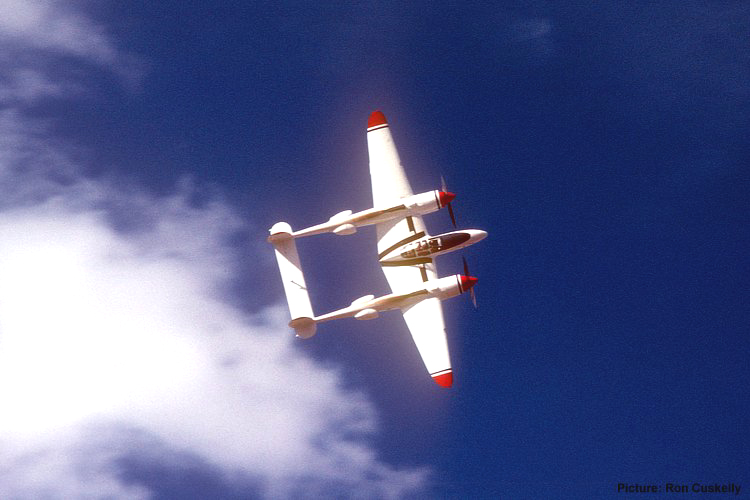 |
||||||||||||||||||||
|
In addition to racing, Lefty Gardner also performed a spirited aerobatic display in P-38L N25Y Race #13 during the 1980 pre-race air show.
|
||||||||||||||||||||
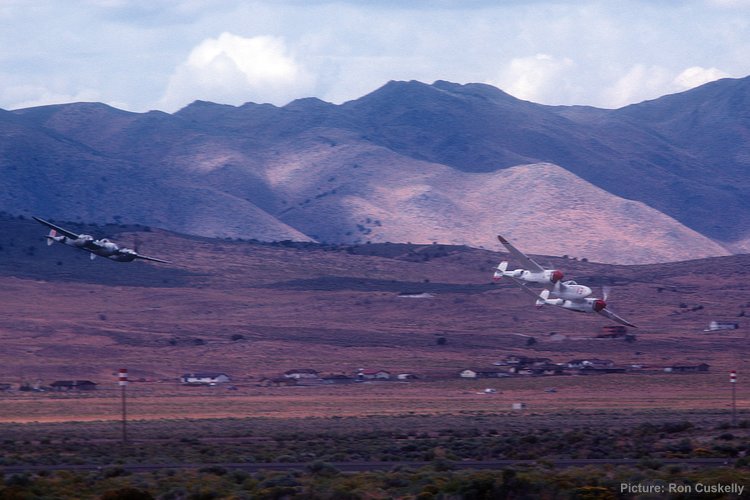 |
||||||||||||||||||||
|
The 1980 races provided the rare spectacle and sound of two P-38 Lightnings going around the pylons. The two aircraft competed in the Bronze race on 12 September with Lefty Gardner in N25Y Race #13 prevailing in 4th at 325.68 mph. Gary Levitz in Race #38 retired on the 4th lap with magneto problems.
|
||||||||||||||||||||
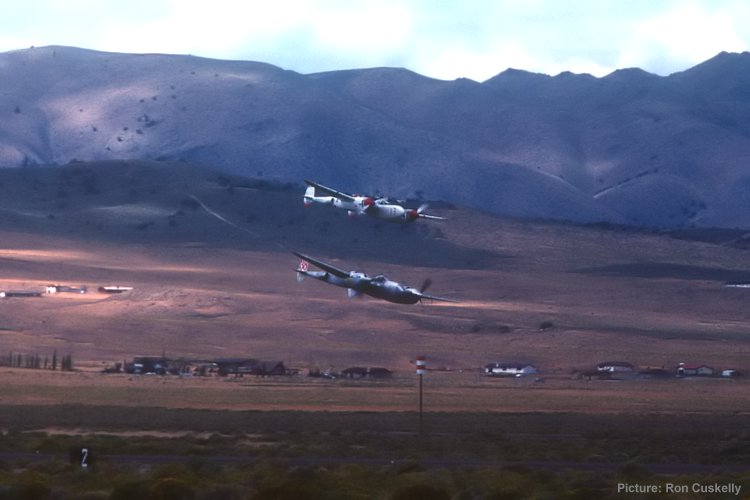 |
||||||||||||||||||||
|
A 300 mph aeroplane was always going to be a challenge for Kodachrome but I had to try. Gary Levitz in N345 Race #38 overtakes Lefty Gardner in N25Y Race #13, probably not long before Levitz retired on the 4th lap with magneto problems. Tragically, Gary Levitz lost his life at Reno on 18 September 1999 when his Mustang N57LR Miss Ashley II suffered an in-flight breakup during a race. Lightning N345 is now displayed at the War Eagles Air Museum in Santa Teresa, New Mexico.
|
||||||||||||||||||||
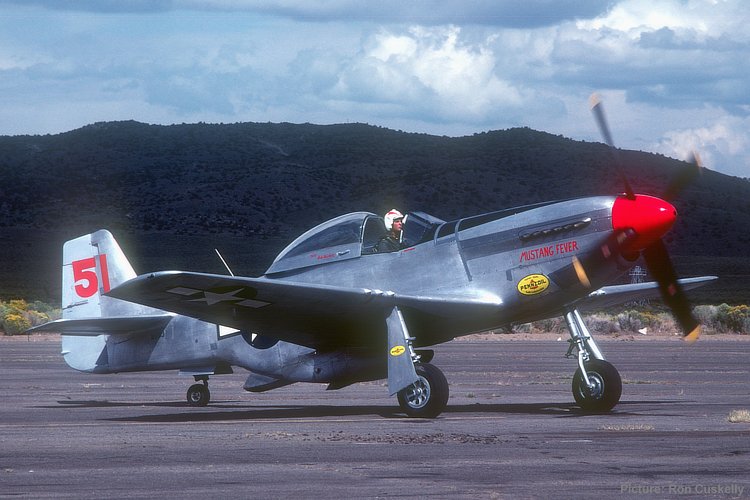 |
||||||||||||||||||||
|
P-51D N51DJ Mustang Fever Race #51 qualified for the 1980 races in 20th at 325.85 mph. Pilot Rick Brickert later moved up from this stock aeroplane to race the Mustang Dago Red and Sea Fury Dreadnought. Tragically Rick Brickert was killed in the crash of the unique Pond Racer at Reno in 1993.
|
||||||||||||||||||||
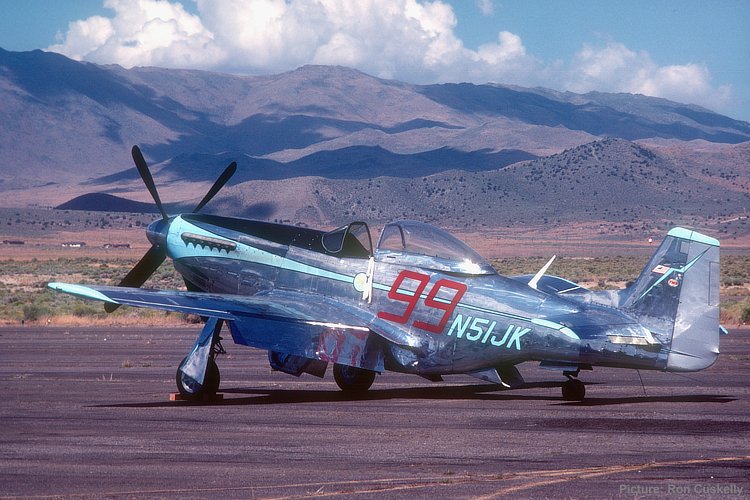 |
||||||||||||||||||||
|
P-51D N51JK Race #99 qualified 16th at 345.65 mph in the hands of Richard Doll. The Mustang was known as Capt. Jack's Wild Horse and came 4th in the Silver final.
|
||||||||||||||||||||
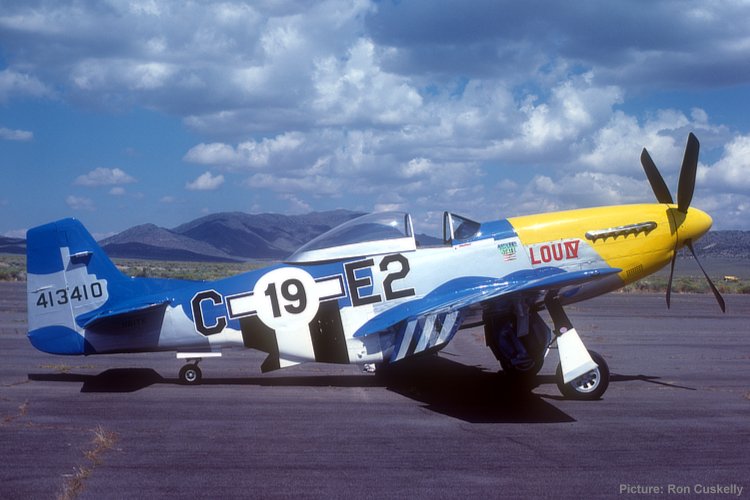 |
||||||||||||||||||||
|
P-51D N51TH Lou IV Race #19, although a basically stock warbird, qualified 10th at 380.98 mph for the 1980 races flown by John Dilley. The aircraft later placed 2nd in the Silver race.
|
||||||||||||||||||||
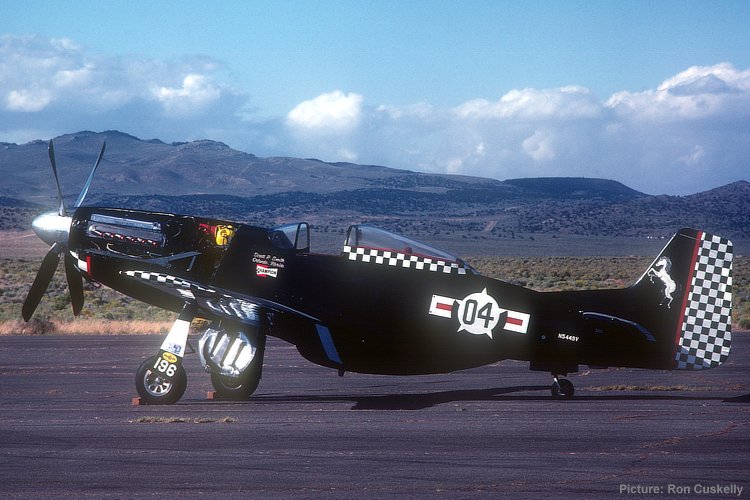 |
||||||||||||||||||||
|
P-51D N5449V Ge Ge II Race #04 qualified 11th at 370.11 mph for the 1980 races flown by Don Whittington. The aircraft won the Bronce race on 13 September and later that same day the same pilot also won the Gold race in his highly modified Mustang Precious Metal Race #09.
|
||||||||||||||||||||
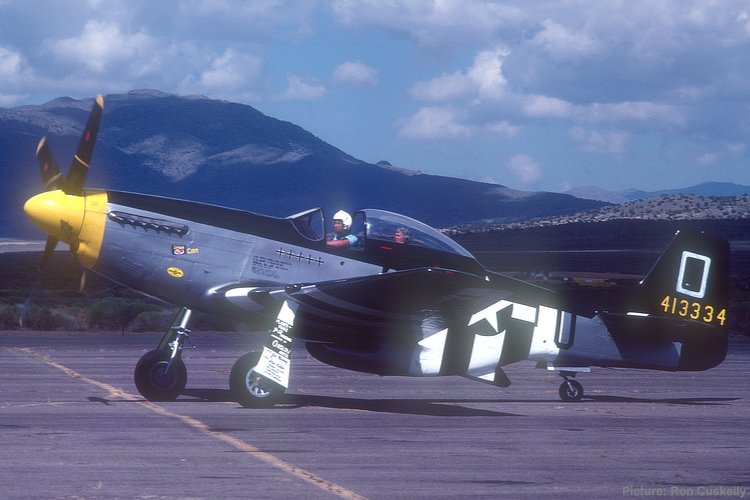 |
||||||||||||||||||||
|
Steve Hinton at the controls of Planes of Fame's P-51D NL5441V Spam Can Race #0. The aircraft qualified 15th at 349.75 mph in the hands of Jim Maloney who flew the aircraft to first place in the Bronze race on 12 September 1980.
|
||||||||||||||||||||
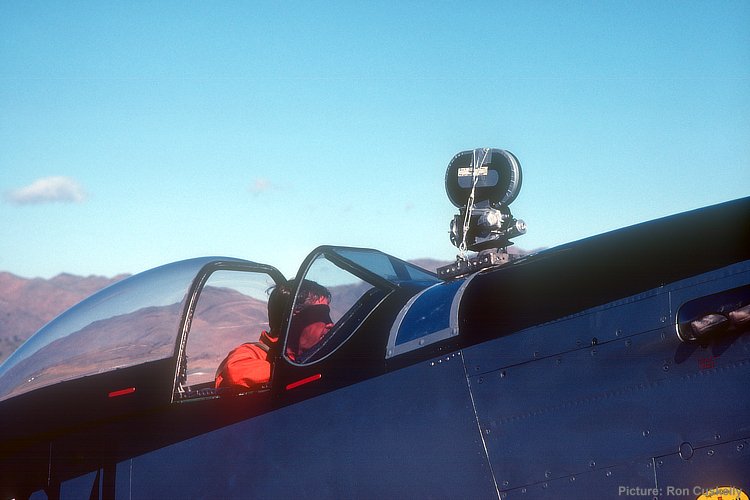 |
||||||||||||||||||||
|
I wish someone would invent the GoPro. Planes of Fame's P-51D NL5441V Spam Can Race #0 no doubt produced some spectacular footage on 13 September 1980.
|
||||||||||||||||||||
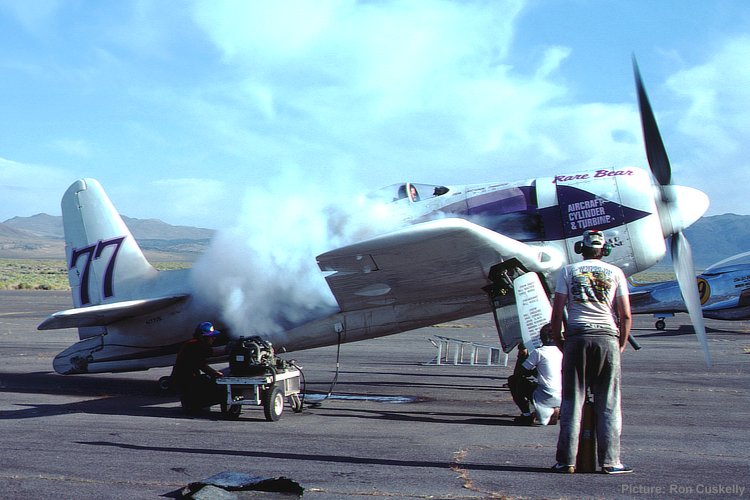 |
||||||||||||||||||||
|
Lyle Shelton's Grumman F8F-2 N777L Rare Bear Race #77 produces a characteristic cloud of smoke from its Wright R-3350. The aircraft qualified 4th at 402.75 mph. The Bearcat retired from the Gold race on 13 September 1980 with a blown engine and did not compete further.
|
||||||||||||||||||||
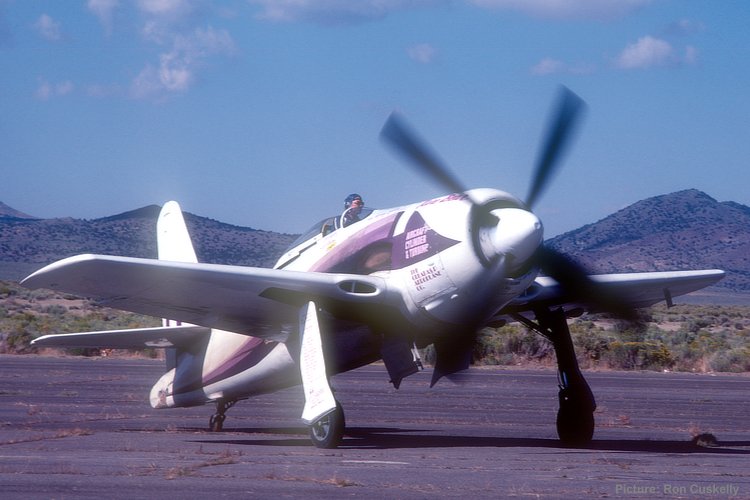 |
||||||||||||||||||||
|
Grumman F8F-2 N777L Rare Bear Race #77 photographed on 12 September 1980.
|
||||||||||||||||||||
|
||||||||||||||||||||
|
|
||||||||||||||||||||
|
|
||||||||||||||||||||
|
|
||||||||||||||||||||